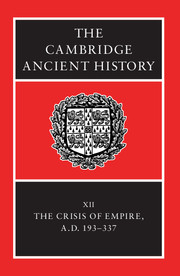Crossref Citations
This Book has been
cited by the following publications. This list is generated based on data provided by Crossref.
Robinson, Chase F.
2010.
The New Cambridge History of Islam.
Whittow, Mark
2010.
The New Cambridge History of Islam.
p.
72.
2010.
A Companion to Families in the Greek and Roman Worlds.
p.
567.
Davis, Raymond
2012.
The Encyclopedia of Ancient History.
Davis, Raymond
2012.
The Encyclopedia of Ancient History.
Davis, Raymond
2012.
The Encyclopedia of Ancient History.
Davis, Raymond
2012.
The Encyclopedia of Ancient History.
Appelbaum, Alan
2012.
Why the Rabbis of the Yerushalmi Called R. Judah Nesiah “a Great Man”.
Journal of Ancient Judaism,
Vol. 3,
Issue. 3,
p.
339.
Sage, Michael
2012.
The Encyclopedia of Ancient History.
Benoist, Stéphane
2013.
La vie des autres.
p.
37.
2013.
The Rise of Gay Rights and the Fall of the British Empire.
p.
40.
Morris, Francis Michael
2015.
Cross‐North Sea Contacts in the Roman Period.
Oxford Journal of Archaeology,
Vol. 34,
Issue. 4,
p.
415.
2018.
Sustainable Urban Logistics.
p.
231.
Pottenger, Andrew J.
2018.
The ‘Servant of God’: Divine Favour and Instrumentality under Constantine, 318–25.
Studies in Church History,
Vol. 54,
Issue. ,
p.
31.
Knitter, Daniel
and
Nakoinz, Oliver
2018.
The Relative Concentration of Interaction—A Proposal for an Integrated Understanding of Centrality and Central Places.
Land,
Vol. 7,
Issue. 3,
p.
86.
Al-Nasarat, Mohammed
2019.
Petra, taxes and trade reconsidered in the light of the Petra Church archive.
Palestine Exploration Quarterly,
Vol. 151,
Issue. 1,
p.
50.
Neumann, Kristina M.
2021.
Antioch in Syria.
Huebner, Sabine R.
2021.
The “Plague of Cyprian”: A revised view of the origin and spread of a 3rd-c. CE pandemic.
Journal of Roman Archaeology,
Vol. 34,
Issue. 1,
p.
151.
Carrié, Jean-Michel
2023.
Les armées et le gouvernement de l’Empire.
Pallas,
Vol. 123,
Issue. ,
p.
123.



